Meister, a Tokyo Tech manufacturing club, participated in the 45th Japan International Birdman Rally 2023 and finished in fourth place, the team’s best result since 2015. The rally was broadcast on national television as one of the most popular summer programs. Ayoob, a member of Meister and a second year GSEP student, tells us an inspiring story from this summer!
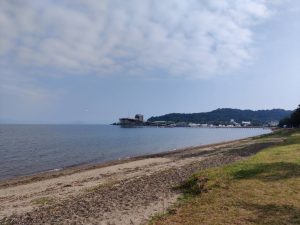
at Lake Biwa
A “Birdman Rally” refers to competitions where participants use gliders or human-powered aircraft and compete based on the distance covered before landing (usually crashing). It is held at the shores of a large water body, where they leap from a seaside jetty or a bridge. They take place at many different places in the world, with the Japanese competition being held at Lake Biwa every summer.
The Japan International Birdman Rally (鳥人間コンテスト) is a human-powered aircraft competition held every year at Lake Biwa, Japan’s largest freshwater lake. It has two parts, one with gliders and the other being human-powered aircrafts with propellers powered by pedals. Various university clubs participate, trying to showcase their knowledge and expertise, with Tokyo Tech being represented by Meister. We work in a warehouse near the 7-11 on campus. It can be identified by the big blue doors.
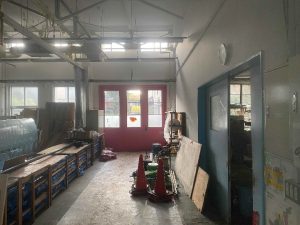
Meister is divided into 6 divisions: wing, p-frame, propeller, pilot, driving parts, electric control, and the fairing division. In the 2022-2023 season, 32 of us worked tirelessly, starting all the way back in August last year. I am in the fairing division, where we focus on designing and building the plane’s main body. We also help each other out at different stages, carrying different parts and materials and making new tools and stands. We often stay back overnight at campus to work and assist other divisions, particularly the girder rolls for the frame.
There are 5 of us In the Fairing division and we fill in a schedule every week to assign the days each of us work on. Our work starts with designing, then printing them out and making different parts from polystyrene. There is a lot of cutting, pasting and measuring involved and we try to be careful but just to be safe, we make spares for different parts.
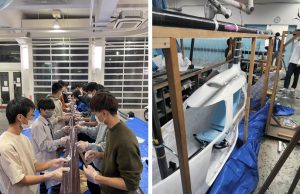
Starting from early May, we had our scheduled test flights. We reserved airstrips near Tokyo, in places such as Saitama and Ibaraki to conduct different trials with the plane and make adjustments and repairs based on it. You can watch our test flights on the YouTube channel here. Those days were very important, and the weather had to be always monitored. This is because the plane is not made for rainy or windy weather and in such situations, we would call the test flight off. The more the test flights, the better, so, we tried to keep one every weekend.
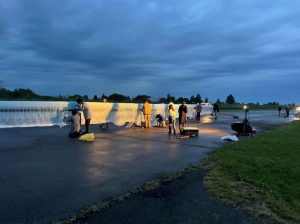
The rain slowed the work down.
We would load all the individual parts in sequence onto a truck on Friday evening, meet at the airstrip, assemble it and perform the tests. After we are done, usually around 10 am the next morning, we do the same in reverse. During all these processes, the most important person, in my opinion, is the pilot, Subaru Kawami. He has to coordinate the divisions along with the leader, Mayu Irie and make sure his comments and requests are received properly. The amount of physical training he has to undergo is no small feat.
I discussed with him about the preparations, and this is what he had to say. “I had to train at least 2 hours each day, every day and maintain a strict diet, which got boring quickly. When I felt like giving in to my cravings, I’d drop by the club and look at others working and get motivated. They got inspired as well seeing me struggle so hard. We all are connected by this strong sense of mutual trust.”
This year’s competition was particularly emotional. Meister has historically been a powerhouse, but the past few years has been quite low by those standards. Last year capped it off, when our plane crashed at around 50 metres. It wasn’t entirely our fault, but it was time, time for a revival. That’s when the Meister revival plan was born and now, on the 29th of July, everything was to be put to test, the team’s determination and hard work, will it pay off?
We left for the competition on the night of July 27th, a Thursday. We arrived in the morning on July 28th, dropped our bags at the hotel and got to work ASAP at the lakeside. Every team had their own spots assigned where they can perform their work and we got to ours and set it all up. This day was for final preparations and adjustments, and so we did. Each division got to work on their part earlier during the day and we assembled it. Everyone worked together and we kept switching people in and out as it was very hot that day, with temperatures exceeding 35 C. We anticipated it would be hot and the pilot even did heat training at 32 C but we didn’t think it would get this hot. The few on their breaks would proceed to distribute drinks and this went on till the evening, when we finished making minor adjustments and got all the parts of the plane approved by the competition organisers. The disassembly was quicker, taking just a couple of hours.
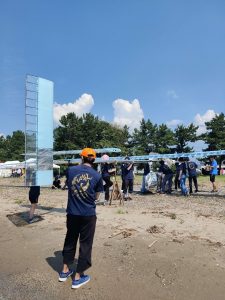
On the day of the competition, work started at dawn. The competition started at around 6:30 in the morning. We were supposed to fly ours later, around noon, so we started assembling ours a bit later than the other teams to keep it in prime condition. As such, the juniors, including me, joined the work bit later, close to 7 am. It started getting hot once again and we continued the same thing as the previous day, switching positions and taking breaks. We were all set but then right around the 6th or 7th teams turn, the wind turned up and the competition had to be put off until the wind died down. In fact, a team was set up on top of the pier but while waiting their parts got damaged, so they had to bring it down and repair it.
We ourselves were struggling quite a bit. The sun started taking toll on the planes body and we had to put on a silver reflector sheet urgently. While we were doing so, the system controlling the yaw and pitch started malfunctioning. We split into two teams, one working on the repair and one on the covers. We pulled through though and finally our turn had come. We got the plane up the ramp and onto the pier. Everyone was watching. We were on national television right now. It was our time.
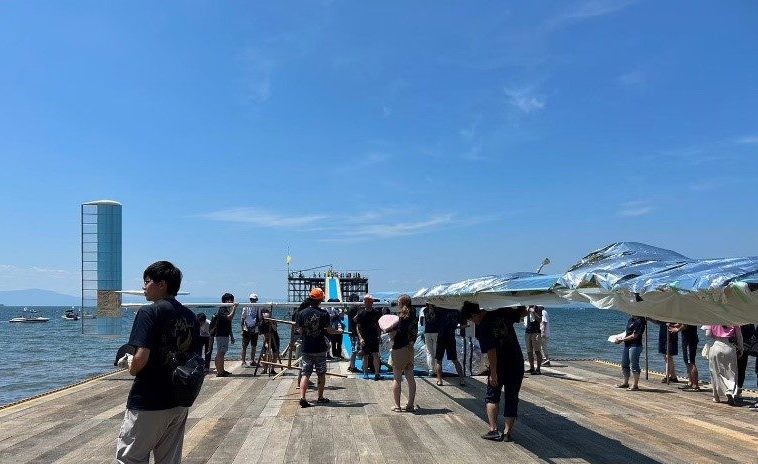
All our hopes were pined on our pilot, Subaru san. Once the set up was done, three of us pushed the plane and here we go, will it fly, will it go long on, we all had these questions and all we could do was hope and watch. And fly it does!
We all came in unity here and cheered on as we watched Subaru san give it his all as he flew. The first years who had just joined our team watched from the shore and they cheered even more passionately than we did. I felt happy seeing that, passionate and brighter future ahead.
With each ascend or descend, our facial expressions changed so much. The feeling that the thing we built was flying high up there felt unreal. It flew for 3,851.83 metres before it crashed into the water. We were second placed at the moment, albeit by the end we got 4th position, which is great in the long-term revival. We members were both happy and dejected at the same time, it is an indescribable feeling. We had risen from the lowest of the lows of last year, but we were still nowhere near we once were. The last time we placed first, the plane had flown for 20 kilometres! This meant that it was only up from here! Everything is set in motion for the years to come.
Mayu Irie, our leader had a few words to share on the flight. “I was aiming for a prize, so I am frankly frustrated, but I was really moved to see the pilot pedalling hard in the strong winds and taking off. I think we will be able to have another flight that will lead us to victory next year. We were able to bring the competition to this point not only because of the efforts of all the members, but also because of the support of so many people and I would like to thank all of them.”
Our turn might have ended but clean-up was still left. The organisers brought the parts back to shore and we loaded it up our truck and got the team photos taken. All of us were still caught in the moments, thinking back to how it flew and how it crashed. It was amazing to see how emotionally absorbed the group was with the project, with some crying tears of joy, a few of sadness.
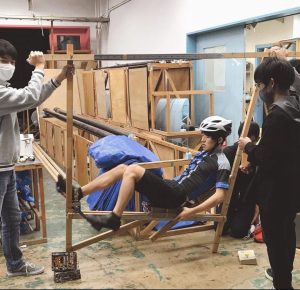
Our main man, Subaru Kawami, described his emotions while piloting our creation. “The flight was in the afternoon and the wind was still strong. Therefore, the conditions were tough. However, the scenery during the flight, the feeling of flying, everything was great. It was the best moment in my life yet. The result was that I was able to fly the longest in Meister’s past five years. I am truly grateful to the members of the club for making such an aircraft. I want to say thank you from the bottom of my heart.”
After loading everything up, we ourselves got on the bus and headed back to Tokyo. We arrived at 2 am and repeated everything again and we were finally done at 3 am, 30th of July. All that was left was to treat ourselves and have some fun, before we start again from scratch, for the 2024 edition. Wish us luck!
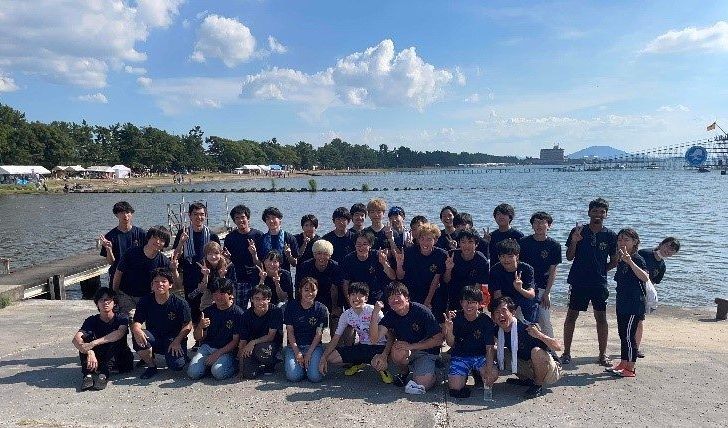
See also the related news on Tokyo Tech homepage.
